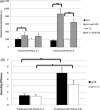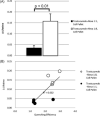Fluorescence lifetime imaging of activatable target specific molecular probes
- PMID: 20101762
- PMCID: PMC3404610
- DOI: 10.1002/cmmi.360
Fluorescence lifetime imaging of activatable target specific molecular probes
Abstract
In vivo optical imaging using fluorescently labeled self-quenched monoclonal antibodies, activated through binding and internalization within target cells, results in excellent target-to-background ratios. We hypothesized that these molecular probes could be utilized to accurately report on cellular internalization with fluorescence lifetime imaging (FLI). Two imaging probes were synthesized, consisting of the antibody trastuzumab (targeting HER2/neu) conjugated to Alexa Fluor750 in ratios of either 1:8 or 1:1. Fluorescence intensity and lifetime of each conjugate were initially determined at endosomal pHs. Since the 1:8 conjugate is self-quenched, the fluorescence lifetime of each probe was also determined after exposure to the known dequencher SDS. In vitro imaging experiments were performed using 3T3/HER2(+) and BALB/3T3 (HER2(-)) cell lines. Changes in fluorescence lifetime correlated with temperature- and time-dependent cellular internalization. In vivo imaging studies in mice with dual flank tumors [3T3/HER2(+) and BALB/3T3 (HER2(-))] detected a minimal difference in FLI. In conclusion, fluorescence lifetime imaging monitors the internalization of target-specific activatable antibody-fluorophore conjugates in vitro. Challenges remain in adapting this methodology to in vivo imaging.
(c) 2010 John Wiley & Sons, Ltd.
Figures





Similar articles
-
Fluorophore-quencher based activatable targeted optical probes for detecting in vivo cancer metastases.Mol Pharm. 2009 Mar-Apr;6(2):386-95. doi: 10.1021/mp800115t. Mol Pharm. 2009. PMID: 19718793 Free PMC article.
-
Dual-modality molecular imaging using antibodies labeled with activatable fluorescence and a radionuclide for specific and quantitative targeted cancer detection.Bioconjug Chem. 2009 Nov;20(11):2177-84. doi: 10.1021/bc900362k. Bioconjug Chem. 2009. PMID: 19919110 Free PMC article.
-
In vivo target-specific activatable near-infrared optical labeling of humanized monoclonal antibodies.Mol Cancer Ther. 2009 Jan;8(1):232-9. doi: 10.1158/1535-7163.MCT-08-0862. Mol Cancer Ther. 2009. PMID: 19139133 Free PMC article.
-
Activatable Alexa Fluor680-conjugated panitumumab and indocyanine green-conjugated trastuzumab cocktail.2012 May 16 [updated 2012 Jul 10]. In: Molecular Imaging and Contrast Agent Database (MICAD) [Internet]. Bethesda (MD): National Center for Biotechnology Information (US); 2004–2013. 2012 May 16 [updated 2012 Jul 10]. In: Molecular Imaging and Contrast Agent Database (MICAD) [Internet]. Bethesda (MD): National Center for Biotechnology Information (US); 2004–2013. PMID: 22787692 Free Books & Documents. Review.
-
Self-quenching Alexa fluor 680 conjugated to trastuzumab.2009 Mar 5 [updated 2009 Apr 6]. In: Molecular Imaging and Contrast Agent Database (MICAD) [Internet]. Bethesda (MD): National Center for Biotechnology Information (US); 2004–2013. 2009 Mar 5 [updated 2009 Apr 6]. In: Molecular Imaging and Contrast Agent Database (MICAD) [Internet]. Bethesda (MD): National Center for Biotechnology Information (US); 2004–2013. PMID: 20641189 Free Books & Documents. Review.
Cited by
-
Near-infrared probes for luminescence lifetime imaging.Nanotheranostics. 2022 Jan 1;6(1):91-102. doi: 10.7150/ntno.63124. eCollection 2022. Nanotheranostics. 2022. PMID: 34976583 Free PMC article. Review.
-
Real-time monitoring of in vivo acute necrotic cancer cell death induced by near infrared photoimmunotherapy using fluorescence lifetime imaging.Cancer Res. 2012 Sep 15;72(18):4622-8. doi: 10.1158/0008-5472.CAN-12-1298. Epub 2012 Jul 16. Cancer Res. 2012. PMID: 22800710 Free PMC article.
-
Molecular probes for fluorescence lifetime imaging.Bioconjug Chem. 2015 Jun 17;26(6):963-74. doi: 10.1021/acs.bioconjchem.5b00167. Epub 2015 May 22. Bioconjug Chem. 2015. PMID: 25961514 Free PMC article. Review.
-
In vivo fluorescence lifetime imaging monitors binding of specific probes to cancer biomarkers.PLoS One. 2012;7(2):e31881. doi: 10.1371/journal.pone.0031881. Epub 2012 Feb 23. PLoS One. 2012. PMID: 22384092 Free PMC article.
-
Multiscale BerEp4 molecular imaging of microtumor phantoms: toward theranostics for basal cell carcinoma.Mol Imaging. 2014;13:10.2310/7290.2014.00016. doi: 10.2310/7290.2014.00016. Mol Imaging. 2014. PMID: 25022347 Free PMC article.
References
-
- Massoud TF, Gambhir SS. Molecular imaging in living subjects: seeing fundamental biological processes in a new light. Genes Dev. 2003;17:545–580. - PubMed
-
- Ntziachristos V. Fluorescence molecular imaging. Annu Rev Biomed Eng. 2006;8:1–33. - PubMed
-
- Weissleder R. Molecular imaging in cancer. Science. 2006;312:1168–1171. - PubMed
Publication types
MeSH terms
Substances
Grants and funding
LinkOut - more resources
Full Text Sources
Other Literature Sources
Medical
Research Materials
Miscellaneous
